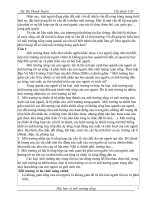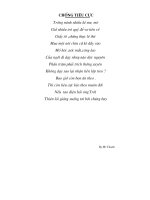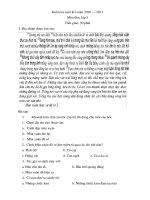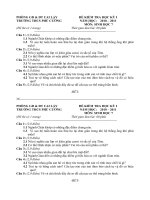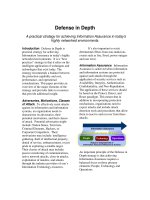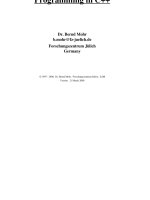Tài liệu Sound in Animation doc
Bạn đang xem bản rút gọn của tài liệu. Xem và tải ngay bản đầy đủ của tài liệu tại đây (114.06 KB, 10 trang )
Sound in Animation
Morgan Ames
CS 294-7, Art of Animation
Spring 2004
Sound in Animation
z “A truth whispered among animators is that 70%
of a show's impact comes from the sound track.”
– Michel Dougherty
z “The right music can help your animation flow,
and sound effects can give your work a solid
feeling that adds to the illusion of life.”
– Mark Simon
z “Sound effects play an important role in
conveying action. Music helps express emotion.”
– Michael Geisler
Sound in Animation
z Scratch track: “sketch” of soundtrack (done with
the storyboard)
z Sound effects can come from standard libraries
(CDs), everyday sources
z Sounds are shorter in animation than in real life
z Doesn’t need to be a connection between object
creating sound and picture! (e.g. coconuts for
horses’ hooves)
z Don’t wait for the animation to be finished to
start thinking about sound!
Crypt1.mov Crypt2.mov Crypt3.mov
First Sound: Steamboat Willie
z First “talking picture:” The
Jazz Singer (1928)
z Steamboat Willie (1928) was
one of the first experiments
in composing an audio
soundtrack for animation
z Willie screened with (live)
sound when animation was
half-finished – test audience
was wildly enthusiastic
History of Music in Animation
z Warner Bros. owned hundreds of songs
{Animation composers required to use a
snippet in every animation
z Disney owned few songs in 20’s and 30’s
{Encouraged composers to write variations on
well-known themes
{Original work in Silly Symphonies, starting
with “Who’s Afraid of the Big Bad Wolf” (1933)
{Music in feature-length animations (1939 on)
Music in Animation: Carl Stalling
z Often regarded as the greatest
animation composer ever
z Started as a organist,
improvisationist for silent movies
z Worked for Warner Bros. 1936 to
1958, after Disney and Iwerks
z Famous for musical gags, from orchestral accents
(pizzicato violins for tiptoe) to obscure references
z We’ve learned that cartoons should work without
the sound. His cartoons worked without the picture!
History of Voices in Animation
z “It feels like the character came from some
place before you see him on the screen, and
when he’s done he’s going to go some place
else. There’s a life for this character that
happens exclusive of the 22 minutes you see
him on screen.” – Rob Paulsen
z “I don’t just stand still in front of the
microphone and speak. I put my full body into
the perfomance just as I would on stage.”
– Greg Burson
Voices in Animation: Mel Blanc
z Radio and Vaudeville
z Started with Warner in 1937
with Porky the Pig, after being
rebuffed for 1½ years
z Bugs Bunny, Daffy Duck,
Foghorn Leghorn, Sylvester
Pussycat, Woody Woodpecker,
Speedy Gonzales, Tasmanian
Devil, Pepe LePew, Marvin the
Martian, Roadrunner, etc.
Whatsup.wav foghorn-goaway.wav
tweety-puddytat.wav
Voices in Animation
z Daws Butler
{Yogi Bear, Huckleberry Hound
{Mentor for many other voice
actors
z Nancy Cartwright
{Acted throughout youth
{Went in to audition for Lisa
Simpson, landed Bart instead
z Recent trend toward using
celebrities for voices
Mel Blanc and Carl Stalling in Action
z Rabbit of Seville
z Fast and Furry-ous (1949)
Thatsa.wma
tweety-puddytat.wav bugs-whatsup.wav
elmer-laugh.wav
marvin-bitnice.wav
daffy-despicable.wav marvin-delitful.wav
foghorn-goaway.wav
